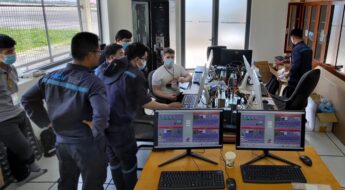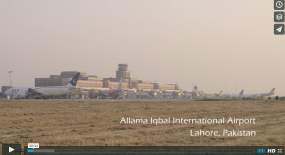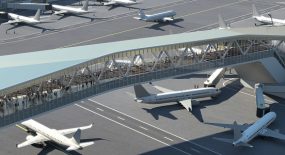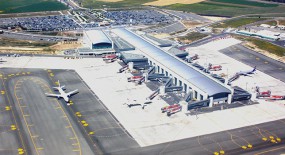
Singapore Changi Airport has two runways with a complex taxiway system connecting to three passenger terminals and one cargo terminal. The airport operates a wide variety of aircraft with approximately 735 movements a day. In 2012 the airport had 51.2 million passengers and over 320,000 aircraft movements. The airports annual growth is in excess of 5% and a third runway is planned for the future.
Airfield Ground Lighting Control and Monitoring System
Ground traffic is divided between 2 Runway controllers and 3 Ground Movement controllers. The new Safegate AGLCMS (Airfield Ground Lighting Control and Monitoring System) is used around the clock as the main ATC (Air Traffic Control) operational system. The routing and guidance functionality enhances safety and provide greater efficiency throughout the movement area. Currently the Singapore Changi Airport (SIN) will use the ADB SAFEGATE AGLCMS for routing and guidance in a semi-automatic mode. However as the AGLCMS is future proofed, the intension is to utilise the AGLCMS to provide a fully automated ATC support tool once the airport achieves complete coverage of surveillance sensors across the entire airport
Advanced mode benefits
In advanced mode the system automatically selects the safest and most efficient route for outbound and inbound traffic based on surveillance and flight plan data. When the controller has approved and confirmed a route generated by the system, the route can be activated to start the airfield lighting guidance for each aircraft. The guidance is started either automatically in the system or by controller activation, in parallel the controller then issues the radio clearance to the cockpit crew or driver. At all times ATC remains in the loop and can modify or reject the systems proposals. The AGLCMS is fully integrated and all safety net alerting from the A-SMGCS system (Advanced Surface Movement Guidance & Control System) is displayed for controller action. Should a runway incursion or area infringement alert occur, the system will send an alert to the controllers.
The integration of the two most important systems in the tower (AGLCMS and A-SMGCS) will provide a much higher situational awareness to the controllers with composite information in one main (AGLCMS) system and elevate the system to A-SMGCS Eurocontrol Level III functionality. This composite information is not normally available in towers today when the systems are operated as separate entities requiring the controller to manually visualize and compose the dual system information.
Safer and more efficient traffic flow
The integration of these two major ATC tower systems into the new AGLCMS will help deliver new operational planning and guidance features into one single system. Real time traffic surveillance data is connected to the airfield lighting to provide dynamic route and guidance of aircraft and vehicle movements at the airport. The dynamic routing and guidance will maintain a safer and more efficient traffic flow at Singapore Changi Airport. The system is capable of supporting all ATC positions on both runways and all taxiways with guidance of the traffic by using the taxiway centreline lights in a procedure called “follow the greens”. By successively lighting the green centreline lights in front of an aircraft or vehicle, pilots or vehicle drivers are guided along the entire cleared route between the runway exit and parking area/stand or from the parking area/stand to the active runway. The centreline lights are switched off behind the aircraft or vehicle to support simultaneous routes to be opened on the same taxiway. Conflicting traffic is resolved with stop bar or virtual stop bar traffic flow management.
During low visibility procedures the “follow the greens” will maintain longitudinal separation of traffic and support increased taxiway throughput. The provision of guidance is based on a continuous taxi speed design to reduce number of turns, stops or braking while taxiing. Reduction of number of turns, stops or braking also reduces the need for excessive acceleration thrust, which in turn also reduces fuel burn and exhaust gases. Integrated safety net route deviation alerting provides an immediate alert to ATC in the event an aircraft or vehicle does not comply with its cleared route thus assisting in the prevention of more serious consequences.
Environmental benefits
It is foreseen that the AGLCMS implementation will provide the Air Traffic Controller with a higher situational awareness of the on-going traffic and give support to a more efficient traffic flow while increasing safety at the airport movement area. The use of efficient dynamic and automatic generated routes on a daily basis will help to decrease aircraft fuel burn and carbon emissions and provide valuable financial saving for both airports and airlines.
ADB SAFEGATE is a leading provider of intelligent solutions that deliver superior airport performance from approach to departure. The company partners with airports and airlines to analyze their current setup and operations, identify bottlenecks, and jointly solve them using a consultative approach that enables airports to improve efficiency, enhance safety and environmental sustainability, and reduce operational costs. Our integrated portfolio includes solutions and services that harmonize airport performance, tackling every aspect of traffic handling and guidance, from approach, runway and taxiway lighting, to tower-based traffic control systems, and intelligent gate and docking automation. ADB SAFEGATE has more than 900 employees in more than 20 countries and operates in more than 175 countries, serving more than 2,000 airports.














Leave a Comment